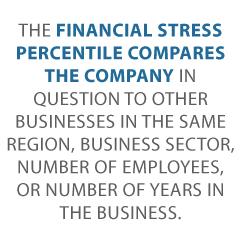Your DB Report
Your DB Report (also known as your (Dun & Bradstreet Report) is a database-generated report. It is one of the first things a business will look at when deciding whether to do so business with you at all. Dun & Bradstreet is a business services giant, and they offer database-generated reports to their clients to help them decide whether you, a potential vendor, supplier, or business partner, are a good credit risk.
A company will rely on the DB Report about your firm in order to make informed business credit decisions and avoid bad debt. The main reason for a client making use of this kind of a report is to engage in credit risk monitoring of merchants, suppliers, and business partners.
Dun & Bradstreet takes several factors into account in creating such a report. These include a predictor of payment delinquency; how financially stressed a company is compared to comparable businesses; an evaluation of supplier risk; credit limit recommendation; D&B rating; and PAYDEX score. Let’s look at all these factors in turn.
Your DB Report: Delinquency Predictor
To figure out how likely your company is to be late in paying your debts, Dun & Bradstreet uses predictive models. They use predictive scoring, which takes historical information to try to predict future outcomes. D & B identifies the risks inherent in a future decision, by comparing historical information to a future event.
The idea is to take objective and statistically derived data, rather than subjective and intuitive judgments. Such scoring enables a business to rank and order accounts based upon the probability of an event taking place, such as delinquent payments. However, note that Predictive Scoring only exemplifies a statistical probability, and not a guarantee.
Financial Stress Percentile 
The Financial Stress Percentile compares the company in question to other businesses in the same region, business sector, number of employees, or number of years in the business. Financial Stress Score Norms
show an average score and percentile for all firms with similar demographic characteristics. These Norms can be utilized in order to benchmark where this particular business stands in relation to the norm for its peer group.
Your DB Report: Financial Stress Score
Dun & Bradstreet generates Financial Stress Scores to predict how likely it is your business will fail over the next twelve months.
D&B defines business failure in several ways. One is as a business which gets legal relief from its creditors. Another is a business which stops its business operations without paying all of its creditors in full. Yet another is a company which voluntarily withdraws from its business operations thus leaving unpaid obligations
Another way is a company which enters into receivership or reorganization. Or it can be a company which makes some kind of arrangement for the benefit of its creditors. And all of this is based upon the information found within D&B’s commercial database.
The score ranges from 1,001 to 1,875. A score of 1,001 represents the highest probability while a figure of 1,875 represents the lowest probability of business failure.
If your company has a lot of lawsuits and liens against it, those will negatively impact your financial stress score.
Financial Stress Risk Class
This is a segmentation of the scored universe into five distinct groups, ranging from 1 to 5. A 1 represents businesses which have the lowest probability of failure, while a 5 represents firms which have the greatest probability of failure.
This Class makes it so a customer can quickly segment their new and existing accounts into various risk segments. This is to determine suitable marketing or credit policies. There is one score for any businesses indicated as being Discontinued at This Location; Higher Risk; or Open Bankruptcy. Those records automatically get a 0 score.
Your DB Report: Financial Stress Score Percentile
A Financial Stress Score Percentile is shown as a 1-100 ranking. Here, a 1 percentile has the highest probability of failure. And a 100 percentile has the lowest probability of failure.
A financially stressed company is specified as a firm which has certain characteristics. It may have ceased operations following assignment of bankruptcy. Another possibility is it has voluntarily withdrawn from business operation leaving unsettled obligations.
Yet another possibility is it has discontinued operations with loss to creditors. Or it could be in receivership or reorganization. Or it may have made some sort of an arrangement for the benefit of its creditors.
Supplier Evaluation Risk Rating
The Supplier Evaluation Risk Rating (also called a SER Rating) calculates how likely it is that a company will get legal relief from its creditors or end its operations without paying creditors in full over next twelve months. The SER rating comes from D&B’s Financial Stress Score. The Financial Stress Score percentile serves as the basis for the SER Rating.
Once there is a Financial Stress Score percentile for a company, a second set of rules apply to figure the SER Rating. The SER Rating provides a probability of worldwide supplier failure. Local countries’ failure ratings come from a Class of 1 – 9. A 1 represents businesses with the lowest probability of supplier failure. A 9 represents companies with the highest probability of supplier failure.
Your DB Report: Credit Limit Recommendation
But first, what is a credit limit? The definition of credit limit is the most credit a financial institution will extend to a client. This credit limit definition works for both personal and business credit.
Beyond that, what is a credit limit? The bottom line is, the credit limit meaning is going to define how much percent of credit you use. A $1000 limit will hit 100% utilization a lot faster than a $10,000 large credit limit. This is your total credit line meaning.
Recommended Dollar Guidelines
Dun & Bradstreet offers what is essentially an abbreviated business recommendation report.
A D & B Credit Limit Recommendation includes two recommended dollar guidelines:
- A conservative limit, suggesting a dollar benchmark if a company’s policy is to extend less credit to minimize risk and
- An aggressive limit, suggesting a benchmark if a firm’s policy is to extend more credit with potentially more risk.
These dollar guideline amounts come from a historical evaluation of the credit demand of customers in the U.S. payments database. These are companies with a similar profile to the firm under evaluation. So, this is with respect to employee size and industry. The guidelines do not address if a specific business can pay that amount. And they don’t say if a particular client has hit their total credit limit.
Each set of limits comes with an analysis of the risk category a firm falls into, or D&B’s assessment of how likely they are to continue to pay their obligations within the agreed-upon terms and how likely they are to undergo financial stress in the next twelve months.
This business recommendation can help any creditor.
Your DB Report: D & B Rating
A D & B Rating helps companies quickly assess your business’s size and composite credit appraisal. Dun & Bradstreet bases this rating on information in your company’s interim or fiscal balance sheet, plus an overall evaluation of the firm’s creditworthiness.
Rating Classifications
5A to HH Rating Classifications show company size based on worth or equity as calculated by Dun & Bradstreet. The figure is important because a firm’s size can be a reliable indicator of credit capacity. Dun & Bradstreet assigns such ratings to firms which have supplied a current financial statement.
Composite Credit Appraisal
This is a number, 1 through 4. So it makes up the second half of a business’s rating. It reflects Dun & Bradstreet’s overall assessment of that firm’s creditworthiness. Dun & Bradstreet’s analysis of company payments, financial information, public records, business age and other important factors, when available, are interpreted in order to generate a Composite Credit Appraisal.
When a firm does not provide current financial information, they cannot get a Composite Credit Appraisal rating of better than a 2. Furthermore, the 1R and 2R Rating categories indicate company size based on the total number of employees for the business.
So these rating classifications go to company files which do not contain a current financial statement. Employee Range (ER) Ratings apply to certain lines of business not lending themselves to classification under the D&B Rating system. These kinds of companies get an Employee Range symbol based upon the number of employees and nothing else.
In general, when Dun & Bradstreet does not have all of the details they need, they will signify as much in their reports. However, the omission of some pieces of information does not necessarily mean a certain firm is a poor credit risk.
Your DB Report: PAYDEX Score
A PAYDEX Score is Dun & Bradstreet’s proprietary dollar-weighted numerical indicator of how a firm has paid its bills over the past year. The score is based upon trade experiences reported to Dun & Bradstreet by a variety of vendors. In addition, the D&B PAYDEX Score ranges from 1 to 100; higher scores signify a better payment performance.
Your DB Report: D & B Data
Finally, any report is only as good as the data it comes from. Dun & Bradstreet’s database contains over 250 million companies spanning the globe. It includes around 120 million active firms. Also, there are about 130 million companies which are out of business but kept for historical purposes.
D & B continuously gathers data and works to improve its analyses to assure the greatest degree of accuracy possible. To ensure as accurate a report as possible, it quite literally pays to provide D & B with your company’s current financial statements. In that way, you will have a far more accurate DB report.
And an accurate DB report means you’ll get a higher D-U-N-S credit score. It’s an important part of how to get business credit. And then you’re far more likely to get business funding.

